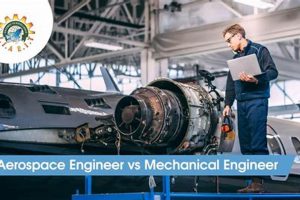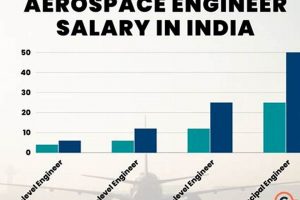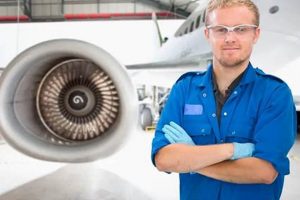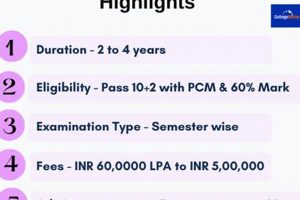The determination of the optimal nation for pursuing a career in aerospace engineering involves evaluating a complex interplay of factors. These factors include the strength of educational institutions, the availability of research opportunities, the presence of a robust industry sector, and the overall economic landscape that supports aerospace innovation and employment.
Significant benefits accrue to individuals who choose a location with a thriving aerospace industry. These benefits encompass access to cutting-edge research and development, enhanced opportunities for professional growth, and the potential for contributing to advancements in aviation, space exploration, and related technologies. Historically, certain nations have established themselves as leaders in aerospace, fostering environments conducive to technological breakthroughs and attracting top talent.
This analysis will delve into key nations renowned for their aerospace sectors, examining their strengths in academic programs, research infrastructure, industry presence, and overall support for aerospace engineers. The assessment will provide a comparative overview, assisting individuals in making informed decisions about where to pursue their education and careers in this dynamic field.
Guidance for Aspiring Aerospace Engineers
Selecting the appropriate nation to cultivate a career in aerospace engineering requires strategic consideration. The following guidance illuminates key aspects to evaluate during the decision-making process.
Tip 1: Research Academic Excellence: Scrutinize university rankings and program curricula. Focus on institutions with dedicated aerospace engineering departments, strong faculty research profiles, and established relationships with industry partners. For instance, the Massachusetts Institute of Technology (MIT) in the United States is consistently ranked highly for its aerospace programs.
Tip 2: Evaluate Industry Presence: Identify nations with a significant aerospace manufacturing base. Countries like the United States, France, and the United Kingdom host major aerospace corporations, providing ample internship and employment opportunities. Boeing and Airbus, for example, maintain significant operations in multiple countries.
Tip 3: Assess Government Investment in Aerospace: Examine the level of government funding allocated to space exploration and aerospace research. Nations with robust government programs, such as the United States (NASA) and the European Union (ESA), often drive innovation and create specialized job markets.
Tip 4: Analyze Research and Development Opportunities: Prioritize countries with active research centers and collaborations. Look for opportunities to engage in advanced research projects, potentially through internships or graduate studies. Germany, for example, has numerous Fraunhofer Institutes involved in aerospace research.
Tip 5: Consider Visa and Immigration Policies: Investigate the ease with which international students and professionals can obtain visas and work permits. Nations with relatively open immigration policies can facilitate career advancement for foreign nationals. Canada, for instance, has programs to attract skilled immigrants.
Tip 6: Examine Cost of Living and Quality of Life: Evaluate the overall cost of living, including housing, transportation, and healthcare, relative to potential salary expectations. Also, assess the quality of life, considering factors such as safety, access to healthcare, and cultural amenities. Switzerland, while expensive, often ranks high in quality of life surveys.
Tip 7: Seek Networking Opportunities: Attend industry conferences and career fairs to establish connections with professionals in the field. Engaging with industry experts provides valuable insights into specific country advantages and potential career paths. The International Astronautical Congress (IAC) is one example.
Strategic evaluation of these factors academic strength, industry presence, government support, research opportunities, immigration policies, and quality of life enables informed decisions regarding the optimal location for a successful aerospace engineering career.
The forthcoming sections will delve into specific nations, analyzing each in relation to these guidelines to provide a more detailed comparative assessment.
1. Academic Institutions' Reputation
The reputation of academic institutions exerts a profound influence on determining optimal locations for aerospace engineering pursuits. Esteemed universities not only provide rigorous curricula but also cultivate valuable networks and enhance career prospects. Their standing directly correlates with the quality of education and the opportunities available to graduates, thereby impacting professional trajectories within the aerospace sector.
- Quality of Faculty and Curriculum
Renowned aerospace engineering programs typically boast faculty composed of leading researchers and industry experts. These instructors offer access to cutting-edge knowledge and practical insights, shaping students’ understanding of fundamental principles and emerging technologies. A well-designed curriculum incorporates theoretical foundations with hands-on experience, preparing graduates for real-world challenges. For instance, Stanford University’s faculty includes prominent figures in satellite technology and propulsion systems, attracting students seeking specialized expertise.
- Research Opportunities and Infrastructure
Top-tier universities invest significantly in research facilities, including wind tunnels, propulsion labs, and advanced materials testing equipment. These resources enable students to participate in groundbreaking research projects, contributing to advancements in areas such as aerodynamics, spacecraft design, and sustainable aviation. Imperial College London, for example, houses state-of-the-art facilities for computational fluid dynamics and composite materials research, fostering innovation among its students.
- Industry Connections and Partnerships
Reputable aerospace engineering programs cultivate strong ties with industry partners, facilitating internships, co-op programs, and collaborative research initiatives. These connections provide students with invaluable practical experience, bridging the gap between academic learning and industry demands. Georgia Tech’s close relationships with companies like Lockheed Martin and Delta Air Lines offer students opportunities to work on real-world projects and gain exposure to industry practices.
- Global Recognition and Alumni Network
Graduates from highly-ranked aerospace engineering programs benefit from global recognition, enhancing their competitiveness in the international job market. A strong alumni network provides valuable connections and mentorship opportunities, facilitating career advancement and professional development. The Massachusetts Institute of Technology (MIT) boasts a vast and influential alumni network within the aerospace industry, spanning leadership positions in government agencies, private companies, and research institutions.
These facets collectively illustrate how the reputation of academic institutions significantly influences the desirability of a nation for aspiring aerospace engineers. Nations housing universities with strong faculty, research infrastructure, industry connections, and global recognition offer a distinct advantage for individuals seeking to excel in this demanding and rapidly evolving field.
2. Industry Job Availability
The correlation between robust industry job availability and identification of leading nations for aerospace engineering is undeniable. The presence of a thriving aerospace sector directly influences the career trajectory and professional growth opportunities available to engineers. Countries characterized by a high concentration of aerospace companies, both domestic and international, inherently offer a more favorable environment for employment and skill development. This concentration stimulates competition, innovation, and ultimately, a higher demand for qualified aerospace professionals.
For instance, the United States, with major aerospace corporations such as Boeing, Lockheed Martin, and Northrop Grumman, provides extensive job prospects across various sub-disciplines, including aircraft design, propulsion systems, and space exploration. Similarly, France, with Airbus and its associated supply chain, constitutes a significant European aerospace hub. Consequently, these nations attract both domestic and international talent, solidifying their positions as premier destinations for aerospace engineers. Conversely, countries with limited aerospace manufacturing or research activities often present a constrained job market, potentially hindering career advancement and specialisation opportunities.
Ultimately, industry job availability serves as a critical determinant in evaluating the suitability of a nation for aerospace engineering careers. Access to diverse roles, opportunities for specialization, and exposure to cutting-edge projects are all direct consequences of a strong industrial presence. Therefore, aspiring engineers must prioritize nations where the aerospace sector is demonstrably active and expanding, ensuring a higher probability of securing fulfilling and impactful employment. Identifying countries with emerging space programs or growing investments in aerospace technologies represents a strategic advantage in navigating a competitive global job market.
3. Research Funding Accessibility
The availability of research funding constitutes a pivotal factor in evaluating the optimal nation for aerospace engineering endeavors. Ample research funding stimulates innovation, attracts top talent, and fosters advancements in critical aerospace technologies, thereby solidifying a nation’s position as a leader in the field. The extent to which researchers can readily access financial resources directly influences the scope and impact of their work, impacting technological progress and industry competitiveness.
- Government Grants and Programs
Governmental bodies frequently provide substantial grants and dedicated programs to support aerospace research. Nations with robust government investment in aerospace R&D often exhibit a more dynamic and innovative environment. For instance, NASA in the United States and the European Space Agency (ESA) in Europe administer significant funding opportunities for researchers across various aerospace disciplines. These grants enable researchers to pursue ambitious projects, develop cutting-edge technologies, and contribute to national aerospace objectives. Countries lacking substantial government support may face limitations in research capacity and technological advancement.
- Industry Partnerships and Sponsorships
Collaborative partnerships between academic institutions and aerospace companies are vital for translating research findings into practical applications. Industry sponsorships provide funding for research projects, access to proprietary data, and opportunities for technology transfer. Nations that foster strong industry-academia collaborations often experience accelerated innovation cycles and enhanced workforce development. For example, partnerships between universities and companies like Boeing and Airbus drive advancements in areas such as aircraft design and manufacturing processes. The absence of these collaborative arrangements can hinder the commercialization of research outcomes.
- Private Funding and Venture Capital
Private funding sources, including venture capital firms and philanthropic organizations, play an increasingly important role in supporting aerospace innovation. Nations with a vibrant ecosystem for private investment often attract entrepreneurs and startups developing disruptive technologies. Venture capital funding can enable the rapid development and scaling of novel aerospace solutions, from advanced materials to autonomous systems. Countries with limited access to private capital may struggle to compete with nations that have well-established private funding mechanisms.
- International Collaboration and Funding Opportunities
Participation in international research collaborations can provide access to additional funding sources and expertise. Collaborative projects funded by international organizations, such as the European Union, enable researchers to pool resources, share knowledge, and address global challenges in aerospace. Nations that actively engage in international partnerships enhance their research capabilities and contribute to global innovation efforts. Countries that isolate themselves from international collaboration may miss out on valuable funding opportunities and expertise.
The accessibility of research funding, encompassing government grants, industry partnerships, private investment, and international collaboration, is intrinsically linked to the attractiveness of a nation for aerospace engineers. Countries that prioritize and support aerospace research create an environment conducive to innovation, attracting talented individuals and fostering technological leadership. A comprehensive assessment of research funding availability is therefore crucial in determining the optimal location for pursuing a career in aerospace engineering.
4. Government Space Program
The presence and scope of a government space program are inextricably linked to the attractiveness of a nation for aerospace engineering professionals. A robust government space program serves as a significant driver for technological innovation, research and development funding, and high-skilled job creation within the aerospace sector. These programs, exemplified by NASA in the United States or ESA in Europe, establish long-term strategic objectives, invest in cutting-edge research, and contract with private companies, creating a ripple effect of opportunity for aerospace engineers. The direct consequence is an increase in demand for engineers specializing in areas such as propulsion systems, spacecraft design, mission control, and satellite technology. Without a significant government commitment, the impetus for groundbreaking research and large-scale projects diminishes, affecting the vitality of the aerospace industry.
Consider the impact of NASA’s Apollo program. This initiative not only landed humans on the moon but also spurred numerous advancements in materials science, electronics, and computer technology. These developments found applications far beyond space exploration, influencing industries ranging from medicine to manufacturing. Moreover, the Apollo program trained a generation of engineers and scientists, many of whom went on to lead subsequent technological innovations. Currently, programs like the Artemis missions are generating similar opportunities, driving research in areas such as sustainable space habitats, advanced propulsion systems, and in-situ resource utilization. The presence of such a program is a powerful attractor for talent and investment.
In conclusion, a substantial government space program serves as a cornerstone for a thriving aerospace industry. It provides funding for crucial research, drives technological innovation, and creates a demand for highly skilled aerospace engineers. Therefore, when evaluating the “best” country for aerospace engineering, the strength and commitment of its government space program must be considered a primary determinant. While other factors, such as academic institutions and industry partnerships, play a role, the foundational support and direction provided by a government space program are essential for sustained growth and leadership in the aerospace field.
5. International Collaboration Opportunities
International collaboration opportunities represent a critical determinant when evaluating nations for aerospace engineering careers. The aerospace sector, inherently global in nature, benefits significantly from the pooling of expertise, resources, and infrastructure across national boundaries. Countries that actively foster and participate in international partnerships provide enhanced opportunities for their aerospace engineers, directly influencing their professional development and contribution to global advancements.
- Joint Research Projects and Funding
Participation in joint research projects allows engineers to access diverse perspectives and skill sets, accelerating innovation and knowledge transfer. International funding mechanisms, such as those provided by the European Unions Horizon program, facilitate collaborative research between universities and industries across multiple nations. This fosters the development of cutting-edge technologies and provides engineers with opportunities to work on large-scale, complex projects. Nations that actively pursue and secure these joint research projects offer their engineers a distinct advantage.
- Access to International Facilities and Expertise
International collaborations often provide access to specialized facilities and expertise that may not be available within a single country. For example, access to wind tunnels, testing facilities, or advanced simulation software located in partner nations can significantly enhance research capabilities. Furthermore, engineers gain exposure to different engineering cultures and approaches, broadening their skill sets and fostering a global perspective. Countries that actively participate in these collaborative networks offer their engineers enhanced resources and learning opportunities.
- Standardization and Interoperability Efforts
Aerospace relies heavily on standardization and interoperability to ensure seamless integration of components and systems across different platforms. International collaboration is crucial for developing and implementing these standards, fostering greater efficiency and safety within the industry. Engineers involved in these efforts contribute to the creation of global benchmarks and gain valuable experience in navigating international regulations. Nations that actively participate in standardization bodies offer their engineers opportunities to shape industry practices and contribute to global harmonization efforts.
- International Space Missions and Programs
Large-scale space missions, such as the International Space Station (ISS) or collaborative lunar exploration programs, are inherently international endeavors. These missions require engineers from multiple countries to work together, sharing expertise and resources to achieve ambitious goals. Participation in these programs provides engineers with unparalleled opportunities to contribute to groundbreaking achievements in space exploration and to develop critical skills in project management, systems integration, and cross-cultural communication. Nations actively involved in these international space missions offer their engineers the chance to participate in some of the most challenging and rewarding projects in the aerospace sector.
In summary, international collaboration opportunities significantly enhance the value proposition of a nation for aerospace engineering professionals. Countries that actively foster and engage in international partnerships offer their engineers access to enhanced resources, expertise, and career-defining projects. Therefore, the extent to which a nation promotes and facilitates international collaboration is a critical factor to consider when evaluating its suitability for aerospace engineering careers.
Frequently Asked Questions
This section addresses common inquiries regarding the identification of leading nations for aerospace engineering endeavors, providing objective and concise answers to facilitate informed decision-making.
Question 1: What key metrics determine the suitability of a nation for aerospace engineering careers?
The evaluation of a nation’s suitability requires considering several key metrics: the strength of academic institutions offering aerospace programs, the presence and growth of the domestic aerospace industry, the level of government investment in aerospace research and development, the accessibility of research funding and facilities, and the extent of international collaboration opportunities available to engineers.
Question 2: How do academic rankings correlate with career opportunities in aerospace engineering?
Academic rankings provide an indicator of the quality of education and research conducted at universities. Institutions with high rankings often attract leading researchers, secure substantial funding, and foster strong industry connections. Graduates from these institutions are typically more competitive in the job market and have access to a broader range of career opportunities.
Question 3: What role does government investment play in fostering a thriving aerospace sector?
Government investment in aerospace research and development is crucial for driving innovation and technological advancements. Government funding supports basic research, infrastructure development, and the creation of high-skilled jobs. A robust government space program also stimulates demand for aerospace engineers and provides opportunities for involvement in cutting-edge projects.
Question 4: Why is international collaboration important for aerospace engineers?
International collaboration enables the pooling of expertise, resources, and infrastructure across national boundaries. It provides engineers with access to diverse perspectives, specialized facilities, and large-scale projects that would not be possible within a single country. Participation in international collaborations also fosters the development of global standards and promotes interoperability within the aerospace industry.
Question 5: How can one assess the strength of the aerospace industry in a specific nation?
The strength of the aerospace industry can be assessed by evaluating the presence and growth of aerospace companies, the level of investment in new technologies, the number of aerospace-related jobs available, and the overall contribution of the aerospace sector to the national economy. Industry reports, government statistics, and company announcements provide valuable insights into these indicators.
Question 6: Are there emerging trends that may shift the landscape of optimal nations for aerospace engineering?
Several emerging trends could influence the landscape, including the growth of the commercial space sector, the increasing focus on sustainable aviation technologies, and the development of autonomous aerospace systems. Nations that proactively invest in these areas and foster innovation in these technologies may emerge as new leaders in aerospace engineering.
These FAQs offer a foundation for understanding the complexities involved in determining ideal countries for aerospace engineering. Continued research and monitoring of industry trends are essential for staying informed.
The following section will discuss further considerations for selecting the appropriate country for aerospace engineering.
Determining Optimal Locations for Aerospace Engineering Pursuits
The preceding analysis has explored critical factors that determine the relative advantages of different nations for individuals pursuing careers in aerospace engineering. These factors encompass the strength of academic institutions, the robustness of industry sectors, the accessibility of research funding, the presence of government space programs, and the availability of international collaboration opportunities. A comprehensive evaluation of these aspects reveals a complex landscape where no single nation definitively holds the title of “best” across all dimensions.
Ultimately, the selection of a nation for aerospace engineering education and career development is a highly individual decision. It should be guided by a thorough assessment of personal priorities, professional aspirations, and the specific areas of specialization one intends to pursue. Continued monitoring of global aerospace trends and proactive engagement with industry professionals will further facilitate informed decision-making in this dynamic and evolving field.







